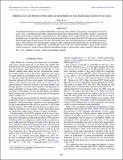THERMAL ESCAPE FROM SUPER EARTH ATMOSPHERES IN THE HABITABLE ZONES OF M STARS
Author(s)
Tian, Feng
DownloadTian-2009-THERMAL ESCAPE FROM.pdf (279.8Kb)
PUBLISHER_POLICY
Publisher Policy
Article is made available in accordance with the publisher's policy and may be subject to US copyright law. Please refer to the publisher's site for terms of use.
Terms of use
Metadata
Show full item recordAbstract
A fundamental question for exoplanet habitability is the long-term stability of the planet's atmosphere. We numerically solve a one-dimensional multi-component hydrodynamic thermosphere/ionosphere model to examine the thermal and chemical responses of the primary CO[subscript 2] atmospheres of heavy super Earths (6-10 Earth masses) in the habitable zones of typical low-mass M stars to the enhanced soft X-ray and ultraviolet (XUV) fluxes associated with the prolonged high-activity levels of M stars. The results show that such atmospheres are stable against thermal escape, even for M stars XUV enhancements as large as 1000 compared to the present Earth. It is possible that the CO[subscript 2]-dominant atmospheres of super Earths in the habitable zones of M stars could potentially contain modest amount of free oxygen as a result of more efficient atmosphere escape of carbon than oxygen instead of photosynthesis.
Date issued
2009-09Department
Massachusetts Institute of Technology. Department of Earth, Atmospheric, and Planetary SciencesJournal
Astrophysical Journal
Publisher
Institute of Physics/American Astronomical Society
Citation
Tian, Feng. “THERMAL ESCAPE FROM SUPER EARTH ATMOSPHERES IN THE HABITABLE ZONES OF M STARS.” The Astrophysical Journal 703, no. 1 (September 2, 2009): 905–909. © 2009 American Astronomical Society.
Version: Final published version
ISSN
0004-637X
1538-4357